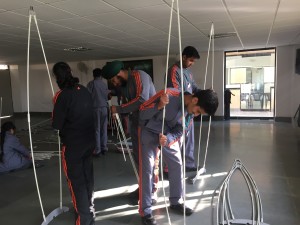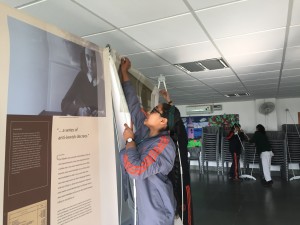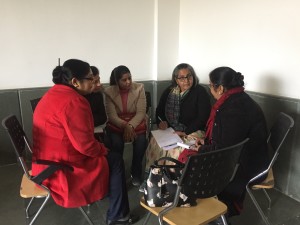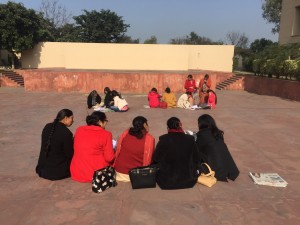Five years since launching the project in India and 9 cities later, we find ourselves in Ludhiana with the Anne Frank exhibition and all its related education activities.
At 4 degrees Celsius it was freezing cold for somebody used to Calcutta winter. But the famous Punjabi warmth and hospitality buffered the bitter cold like nothing else possibly could!
Day 1. Peer Guide Training [6.1.2018]
One of the primary foundations of the Anne Frank exhibition is learning through, with and by peers. The peer-guide training workshop sets the stage for this perfectly.
Since the group already knew each other rather well I skipped the ice breaking exercise and went straight into the all important first question: Who is familiar with The Diary of Anne Frank? Immediately all 18 hands went up and I must admit, although I expected no other response to my question, it still amazes me—the fact that across cities in India most young adults seem to have at some point been introduced to Anne Frank’s diary. When Otto Frank decided to publish his daughter’s diary, I wonder if he had any inkling of what its reach would be worldwide.
We dived headlong into discussing Anne’s life, times and her writing and the emotions these evoked in the students.
Then came the part with the physical work. Opening the boxes that contain the exhibition, understanding the structure, discussing basic elements that need to be thought of while setting up a display and so on. Soon I could see that the students were taking ownership of the project and enjoying the process of ‘constructing’ the exhibition and figuring out the best way to design the flow and display. Two hours of loud chatter, deep excitement and tiring work later it was time to be calm and quiet and settle down into getting familiar with the content on each of the panels.
The change in the mood was palpable. From empathy to anger and disbelief, the participants immersed themselves into identifying key issues that they would like to highlight while they guide visitors to the exhibition.
‘You will probably come across diverse reactions from visitors—interest, surprise, pity, disgust, skepticism, dismissal and even boredom. Always try to remember why this exhibition is important to you’, I said. ‘Draw their attention to particular pictures on the panels. Discuss these. Ask your visitor what they may know about a particular event or photo. And most important, return frequently to the subject of what these historical issues mean to us today’.
In the beginning some out of the group of 18 were grappling, but a few mock sessions later they were more than ready to become informed guides to the exhibition.
Day 2. Teacher Training [7.1.2018]
Not being an educator, this is one workshop I am always nervous about facilitating. The only thing that does work in my favour is that this workshop is to get teachers familiar with a Human Rights Teacher Resource developed by me, so the content is very familiar!
I entered the classroom to encounter a group of 32 teachers from very diverse schools.
We began with an icebreaker and introductions that went a little deeper than telling each other our names and where we work. The idea was to get a foothold into a discussion on identity through this icebreaker. Introductions done I screened a short performance video by Hetain Patel that plays with identity, language and accents to challenge stereotypes. The humour in this piece went down extremely well and the entire group sank into an intense exchange on issues of identity.
We could have carried on with this topic all day, but I had to steer the session to a few other issues to give the participants a broad idea of the contents of the Human Rights Education Resource.
Based on the Anne Frank story, the module covers Genocides across the world over the past seven decades and history of Human Rights—moving into step by step explorations of the articles from the human rights charter, linking them to current affairs using film, photography and literature. Each of the topics provide assignment ideas for classroom practice and the module ends with ideas for community projects. The aim is for teachers to inspire their students to become Human Rights Defenders.
We picked two assignments from the module and the participants worked on them in groups. The hands on approach gave them a feel of the aims of the module and I hope to hear back from them soon with reports of how this is being used in their classrooms.
Day 3. Opening of Exhibition [8.1.2018]
On the morning of 8 January 2018, the entire senior school gathered in the large space where we had set up the exhibition, to attend the opening ceremony.
Chief Guest Mr Jaswant Zafar, a distinguished poet, philosopher and author, spoke eloquently on the art and the importance of ‘listening’. A group of nine students rendered prayers before lighting the ceremonial lamp. Peer guides were then ready to put their newly acquired knowledge and skills in practice for all the visitors present.
– Meena Malhotra




